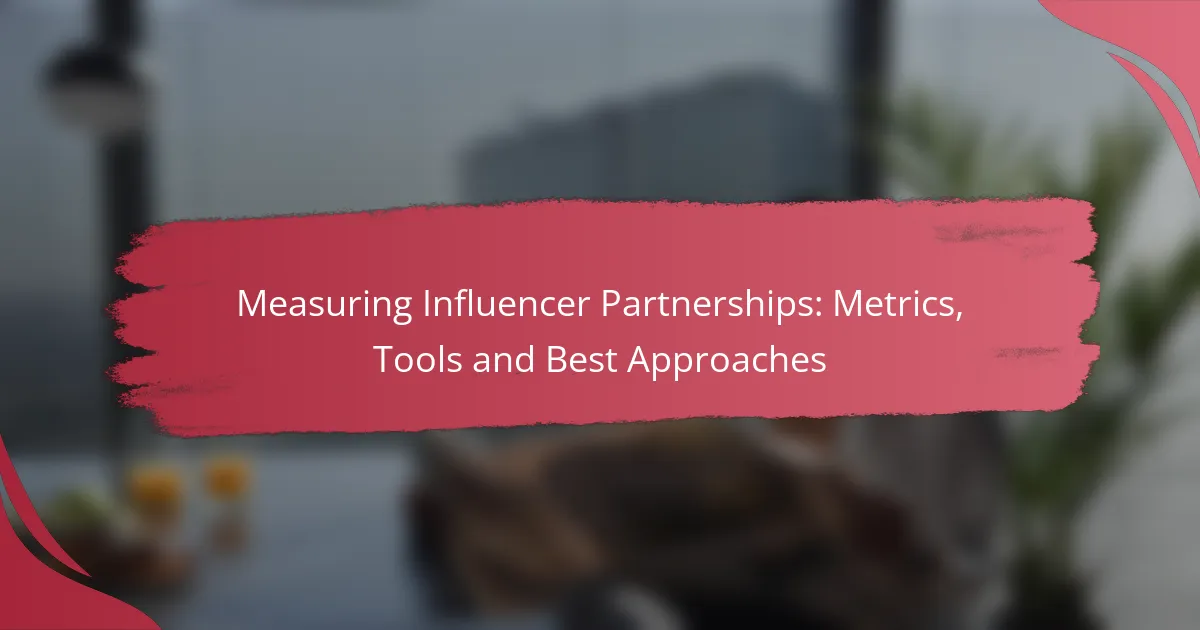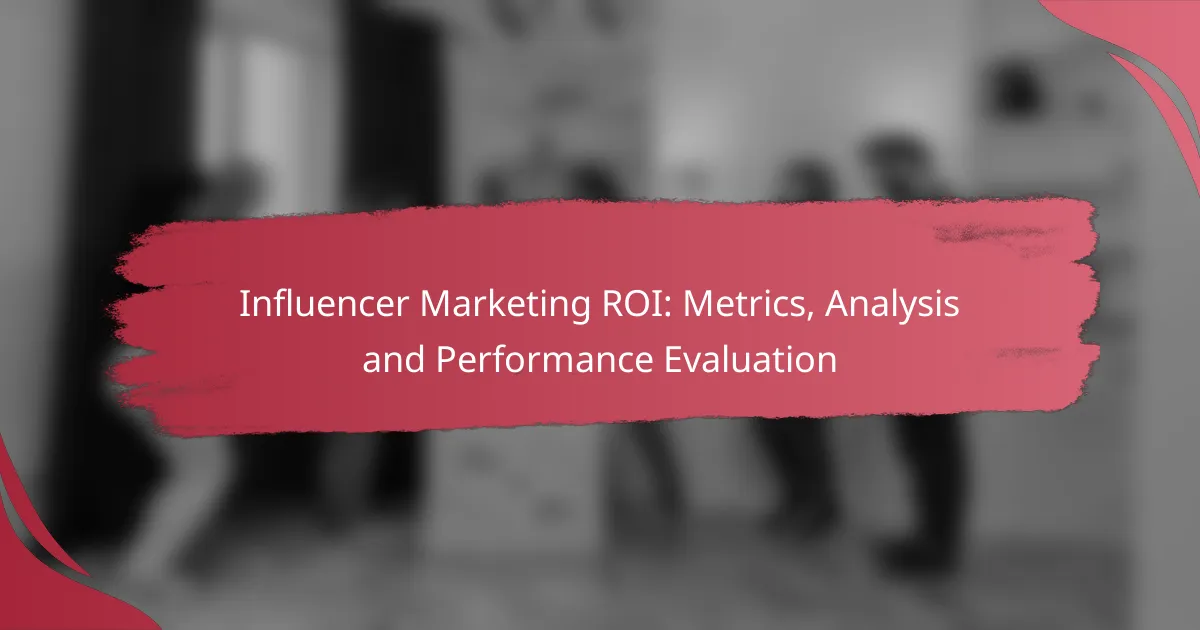Measuring the success of influencer partnerships is crucial for brands aiming to enhance their visibility and sales. Key metrics such as engagement rate, reach, and ROI provide valuable insights into the effectiveness of these collaborations. Utilizing specialized tools can further aid in tracking performance, enabling brands to make informed, data-driven decisions for future campaigns.
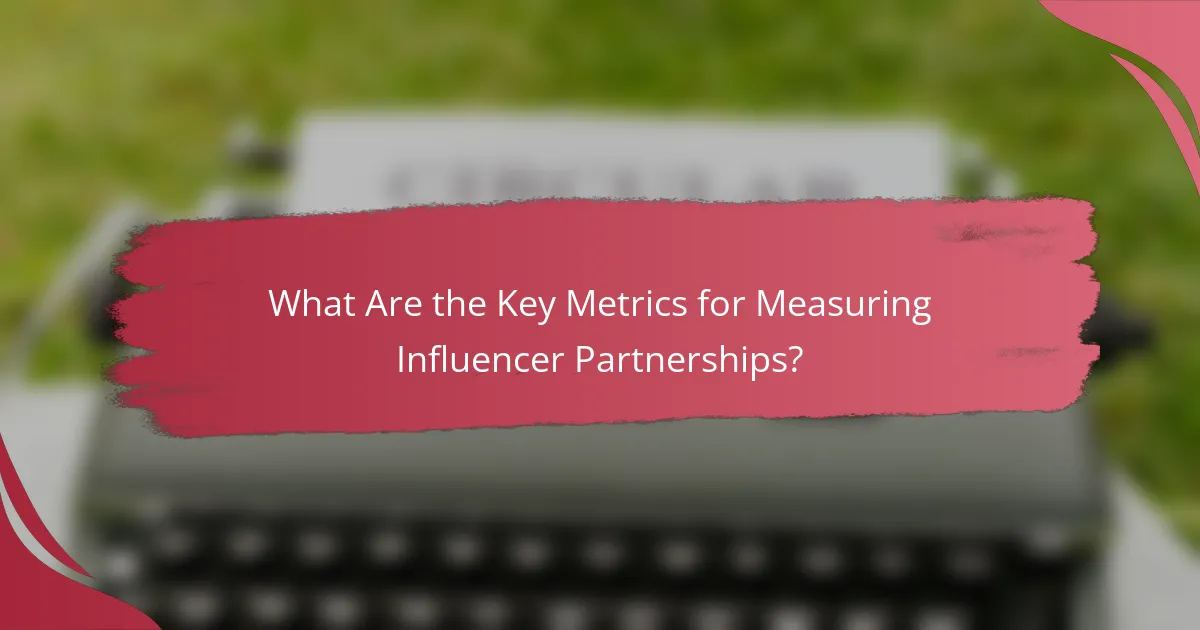
What Are the Key Metrics for Measuring Influencer Partnerships?
Key metrics for measuring influencer partnerships include engagement rate, reach and impressions, conversion rate, return on investment (ROI), and brand sentiment analysis. These metrics provide insights into the effectiveness and impact of influencer collaborations on brand visibility and sales performance.
Engagement Rate
Engagement rate measures how actively an audience interacts with an influencer’s content, typically expressed as a percentage of total followers. It is calculated by dividing the total interactions (likes, comments, shares) by the number of followers, then multiplying by 100. A higher engagement rate indicates a more connected audience.
For brands, an engagement rate between 1% to 3% is generally considered average, while rates above 3% are often viewed as strong. Monitoring engagement helps assess the quality of the influencer’s audience and the potential effectiveness of the partnership.
Reach and Impressions
Reach refers to the total number of unique users who see an influencer’s content, while impressions count the total number of times the content is displayed, regardless of whether it was clicked or not. Both metrics are crucial for understanding the visibility of a campaign.
Brands should aim for a balance between reach and impressions to maximize exposure. For example, a campaign with high impressions but low reach may indicate repetitive views from the same audience, which could limit new customer acquisition.
Conversion Rate
Conversion rate measures the percentage of users who take a desired action after engaging with influencer content, such as making a purchase or signing up for a newsletter. This metric is vital for assessing the effectiveness of influencer partnerships in driving sales.
To calculate conversion rate, divide the number of conversions by the total number of visitors from the campaign, then multiply by 100. A conversion rate of 2% to 5% is often seen as effective in e-commerce settings. Brands should track this metric to refine their strategies and improve future campaigns.
Return on Investment (ROI)
ROI evaluates the financial return generated from influencer partnerships relative to the costs incurred. It is calculated by subtracting the total campaign costs from the total revenue generated, then dividing by the total campaign costs and multiplying by 100.
A positive ROI indicates a successful campaign, while a negative ROI suggests a need for reevaluation. Brands should set clear financial goals and track expenses meticulously to ensure accurate ROI calculations, aiming for at least a 3:1 revenue-to-cost ratio for effective campaigns.
Brand Sentiment Analysis
Brand sentiment analysis gauges the overall perception of a brand as expressed in comments, reviews, and social media interactions following an influencer campaign. This qualitative metric helps brands understand how their audience feels about them after exposure to influencer content.
Tools like sentiment analysis software can categorize feedback as positive, negative, or neutral. Brands should monitor sentiment trends over time to assess the long-term impact of influencer partnerships on brand reputation and customer loyalty.
![]()
Which Tools Are Best for Tracking Influencer Performance?
Effective tracking of influencer performance relies on specialized tools that provide insights into engagement, reach, and overall impact. The right tools can help brands evaluate partnerships and optimize future campaigns based on data-driven decisions.
Hootsuite
Hootsuite is a comprehensive social media management platform that allows brands to track influencer performance across multiple channels. Users can monitor engagement metrics, schedule posts, and analyze audience interactions in real-time.
With Hootsuite, brands can create custom reports that highlight key performance indicators (KPIs) such as likes, shares, and comments. This data helps in assessing the effectiveness of influencer collaborations and adjusting strategies accordingly.
BuzzSumo
BuzzSumo excels in content analysis and influencer identification, making it a valuable tool for tracking influencer performance. It allows brands to discover trending topics and measure how influencers engage with their audience through shares and backlinks.
Using BuzzSumo, brands can evaluate the reach and impact of influencer content by examining metrics like social shares and engagement rates. This insight is crucial for determining which influencers are driving the most value for a brand.
Sprout Social
Sprout Social provides in-depth analytics and reporting features that help brands assess influencer performance effectively. It offers tools for monitoring social media conversations and measuring engagement metrics across various platforms.
Brands can utilize Sprout Social to track specific campaigns and analyze how influencer partnerships contribute to overall brand awareness and customer engagement. The platform’s user-friendly interface makes it easy to generate reports that highlight key insights.
Google Analytics
Google Analytics is a powerful tool for tracking website traffic and user behavior, making it essential for measuring the impact of influencer partnerships on web performance. By setting up specific goals, brands can see how influencer-driven traffic converts into actions, such as purchases or sign-ups.
To effectively use Google Analytics, brands should create UTM parameters for influencer links, allowing them to track the source of traffic accurately. This data helps in understanding the ROI of influencer collaborations and refining future marketing strategies.

How to Establish Effective Influencer Partnerships?
To establish effective influencer partnerships, brands must align their goals with the right influencers and create a collaborative strategy. This involves defining clear objectives, selecting suitable influencers, and working together to achieve mutual benefits.
Define Clear Objectives
Setting clear objectives is crucial for any influencer partnership. Brands should identify what they aim to achieve, whether it’s increasing brand awareness, driving sales, or enhancing engagement. Specific goals help in measuring success and guiding the overall strategy.
Consider using the SMART criteria—Specific, Measurable, Achievable, Relevant, Time-bound—to frame your objectives. For example, instead of a vague goal like “increase sales,” a SMART goal would be “increase online sales by 20% within three months through influencer promotions.”
Choose the Right Influencers
Selecting the right influencers is essential for effective partnerships. Brands should look for influencers whose audience aligns with their target market and whose values resonate with their brand. This alignment increases the likelihood of authentic engagement.
Consider factors such as audience demographics, engagement rates, and content style. Tools like social media analytics platforms can help assess potential influencers. Aim for influencers who have a genuine connection with their followers, as this can lead to higher conversion rates.
Develop a Collaborative Strategy
A collaborative strategy involves working closely with influencers to create content that reflects both the brand’s message and the influencer’s unique style. This partnership should be built on open communication and shared creative input.
Establish clear guidelines while allowing room for the influencer’s creativity. For instance, provide key messages and campaign goals, but encourage influencers to present them in their own voice. Regular check-ins can help ensure that both parties are aligned throughout the campaign.
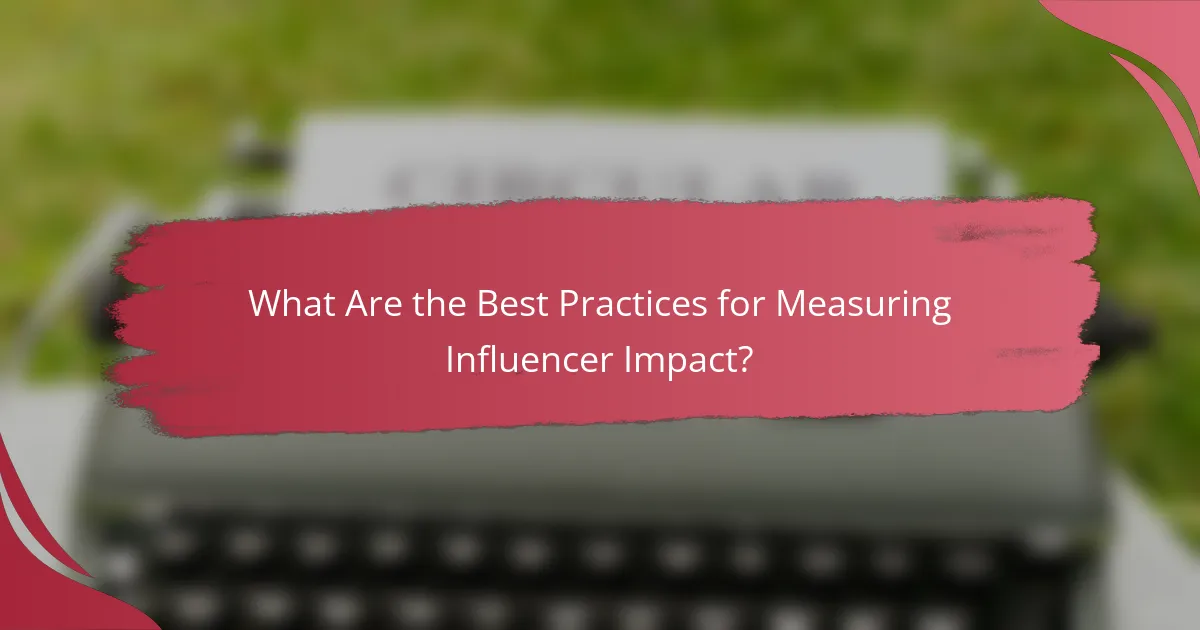
What Are the Best Practices for Measuring Influencer Impact?
To effectively measure influencer impact, focus on specific metrics that align with your campaign goals. Best practices include setting up tracking links, utilizing A/B testing, and monitoring social listening to gather comprehensive data on engagement and reach.
Set Up Tracking Links
Tracking links are essential for measuring the performance of influencer partnerships. By creating unique URLs for each influencer, you can monitor traffic, conversions, and sales generated from their content. Use URL shorteners or tracking software to simplify the process and ensure accurate data collection.
When setting up tracking links, consider using UTM parameters to categorize the traffic sources. This allows for detailed analytics in platforms like Google Analytics, helping you understand which influencers drive the most value. Regularly review these metrics to optimize future collaborations.
Utilize A/B Testing
A/B testing enables you to compare different content strategies and determine what resonates best with your audience. By collaborating with multiple influencers and testing variations in messaging, visuals, or calls to action, you can identify the most effective approaches.
For instance, if one influencer promotes a product with a discount code while another uses a giveaway, analyze the engagement and conversion rates of each. This data-driven approach helps refine your influencer strategy and maximize ROI.
Monitor Social Listening
Social listening involves tracking conversations and mentions of your brand across social media platforms. By monitoring influencer content and audience reactions, you can gauge sentiment and identify trends that inform your marketing strategy.
Utilize tools like Hootsuite or Brandwatch to track keywords and hashtags related to your campaign. This will help you understand how your audience perceives the influencer partnership and whether it aligns with your brand values. Regularly assess this feedback to adjust your influencer strategy as needed.
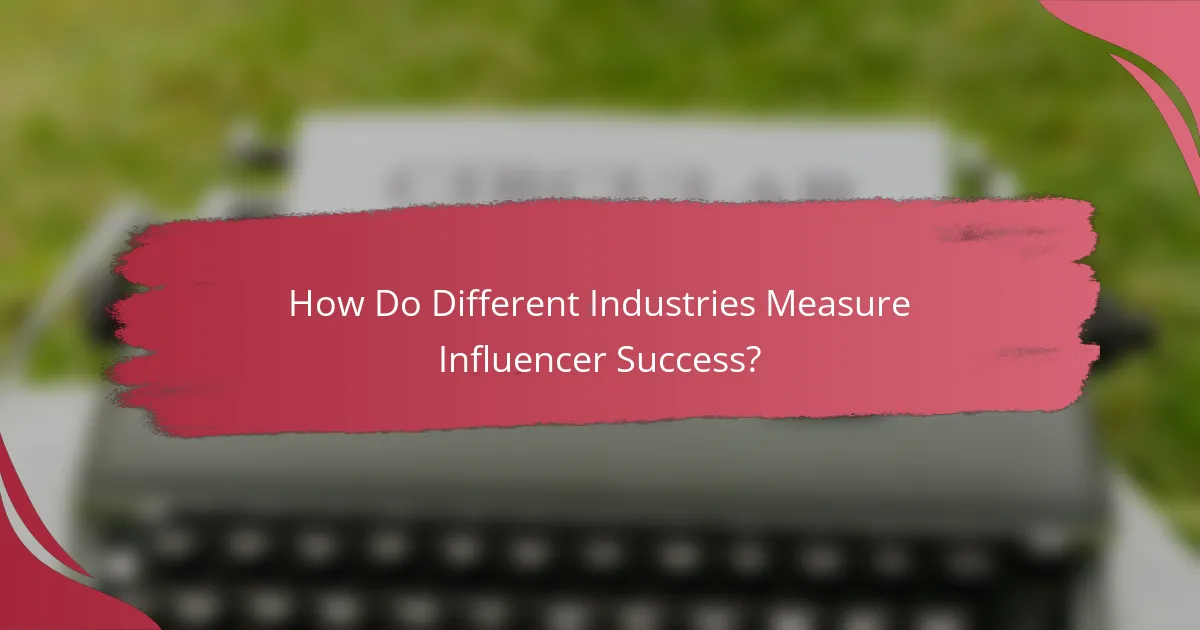
How Do Different Industries Measure Influencer Success?
Different industries measure influencer success through specific metrics that align with their unique goals and target audiences. Key performance indicators (KPIs) such as engagement rates, conversion rates, and reach vary significantly across sectors, influencing how brands assess the effectiveness of their influencer partnerships.
Fashion Industry Metrics
In the fashion industry, metrics often focus on visual engagement and brand awareness. Key indicators include likes, comments, shares, and follower growth on platforms like Instagram and TikTok. Brands may also track the number of saved posts and the reach of influencer campaigns to gauge visibility.
Conversion metrics, such as click-through rates to online stores and sales generated from unique discount codes, are crucial. For example, a successful influencer partnership might yield a conversion rate of 3-5%, depending on the influencer’s audience alignment with the brand.
Tech Industry Metrics
The tech industry typically emphasizes metrics related to audience engagement and lead generation. Important KPIs include website traffic driven by influencer content, sign-ups for newsletters, and demo requests. Brands often analyze the quality of leads generated, focusing on how many convert into paying customers.
Engagement rates on platforms like LinkedIn and YouTube are also vital, with a focus on comments and shares that indicate deeper interest. A conversion rate of 5-10% from influencer-driven campaigns is often considered successful in this sector.
Food and Beverage Metrics
In the food and beverage sector, metrics often center around consumer engagement and purchase intent. Brands track social media interactions, including likes and comments, as well as the number of recipes or product uses shared by influencers. Engagement rates of 4-6% are common benchmarks for successful campaigns.
Sales metrics are crucial as well, with brands monitoring the impact of influencer promotions on in-store purchases or online orders. Unique promo codes can help track conversions, with effective campaigns typically achieving a 10-15% increase in sales during promotional periods.
